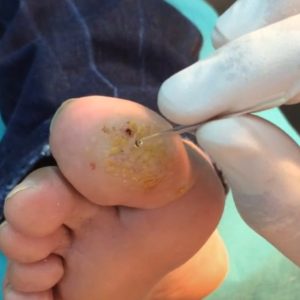Verrucae and Warts
Verrucae / Warts…
What is it?
Verruca Pedis (VP) is a type of benign skin lesion arising from a viral infection of the epidermis. Verrucae are synonymous with ‘warts’ and can occur on any area of the skin, though they are most commonly found on the hands and feet. When these appear on the weight-bearing surfaces of the feet they can develop an overlying callosity which can make them painful. They are otherwise a harmless skin lesion.
 What causes it?
What causes it?
The virus responsible for verrucae is the Human Papilloma Virus. There are many strains of this virus, but the three most common for causing verrucae and warts are HPV 1, 2 and 4 (there are others too). Thankfully, all of these strains are the benign subtypes though some cancers can resemble viral warts. As such, it is always important to have suspected verrucae investigated by a podiatrist/FHP.
HPV is ubiquitous. Strains causing verrucae and warts are found commonly on the hands of most people as well as many inanimate objects that we come into contact with each day. However, it is a weak virus insomuch as it is easily washed off of the outer layer of the epidermis as well as easily washed off of inanimate objects. The strains responsible for verrucae and warts only cause infection when they get access to the base layer of the epidermis. It is because the cells that they target for viral replication are metabolically active keratinocytes which are found at this base layer. As the epidermis provides a very robust barrier to most things, it takes a breach in the outer layers of the epidermis to allow the virus to access these metabolically active active keratinocytes to cause infection. Thus, if the skin is excessively wet or macerated or has been subject to micro tears, the risk of infection increases (this is why swimmers are particularly susceptible to verrucae).
Once at the site, provided the individual does not have immunity to the infection, the latent phase of the infection (i.e. incubation) is typically quite slow and is estimated to be anywhere between 6 weeks and 8 months. This is because the viral replication with the affected keratinocytes is slower and less directly cell-damaging relative to other viral infections. The process of virus replication produces proliferation of prickle cells which alters the character of the epidermis, resulting in the visible warty appearance of the verrucae. The nature of the slow viral replication, the epidermis being out of reach of the body’s immune system and the ability of the virus to evade detection through localised cytokine suppression means that verrucae and warts can be a persistent skin lesion that struggles to respond to a range of treatment options. The way in which lesions will typically disappear is through ‘spontaneous resolution’ – in other words the body eventually identifies its presence and mounts the necessary immune response.
How do I treat it?
Often treatment is not indicated. In many instances the nature of the lesion needs to be carefully explained to the patient and/or parent/carer. On the back of that discussion, unless the verruca is painful or causing other considerable concerns, it is often left alone to allow the body to eradicate the infection in time. However, instances where the verruca is proving problematic in either the form of pain or psychosocial distress, some treatment options may be considered. These include:
• Scalpel Debridement
A simple reduction in the hard skin build-up over the lesion. This is not a treatment aimed at resolving the lesion so much as it is aimed at reducing callus-associated discomfort. This will typically require repeating regularly.
• Occlusion
The use of occlusive tape (i.e. zinc oxide tape) to ‘lock in’ moisture at the skin surface serves to macerate the lesion. This reduces the dryness and hardness of the lesion which is pain relieving . There is also some evidence that as maceration is a type of controlled wound state, this may induce an inflammatory response which could expedite the immunological response to resolving the lesion.
• Verrutop
Verrutop is a professionally administered, non-caustic, treatment designed to break down the viral material in the verrucae and encourage them to detach. Clinical studies with Verrutop show that up to 90% of verrucae clear within 6 fortnightly treatment cycles. Verrutop is safe and painless and can be used in adults and children aged 6 years and above.
Book now for Verrutop Treatment at Faversham Feet. Click Here!
• Caustics
Different acids have historically been used to treat verrucae with varied success. These cause a chemical burn and keratolytic response to the affected tissue. This does reduce some of the callosity at the site and may induce an inflammatory reaction, in turn potentially expediting the immunological response. However, there are risks to consider and this treatment is more cautiously considered for individuals whose feet are deemed ‘at risk’.
• Cryotherapy
The use of profoundly cols temperatures to ‘freeze’ the lesion also remain a mainstay of verruca treatment. Causing the lesion to freeze and potentially burst may expose the live virus to parts of the immune system with the blistered and often painful response to the procedure invoking an immune response.
We have a local cryotherapist, Amy Garske, at Syndale. You can find more information at www.cryotherapybyamy.co.uk
• Faulkner’s Needling
This is a procedure performed under a local anaesthetic where a hypodermic needle is advanced through the lesion many, many times to create a wound and to expose the virus to sub-dermal tissue to invoke an immune response.
We can recommend a podiatrist, Lucy Wilcox, offering needling at Easy Feet Podiatry in Ashford. You can find more information at www.easyfeetpodiatry.co.uk
• Surgery
For some cases, surgical excision of the lesion is necessitated. However, this does not typically result in an immunological response to eradicate the lesion making someone susceptible to future development of a verruca.
